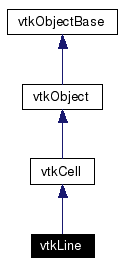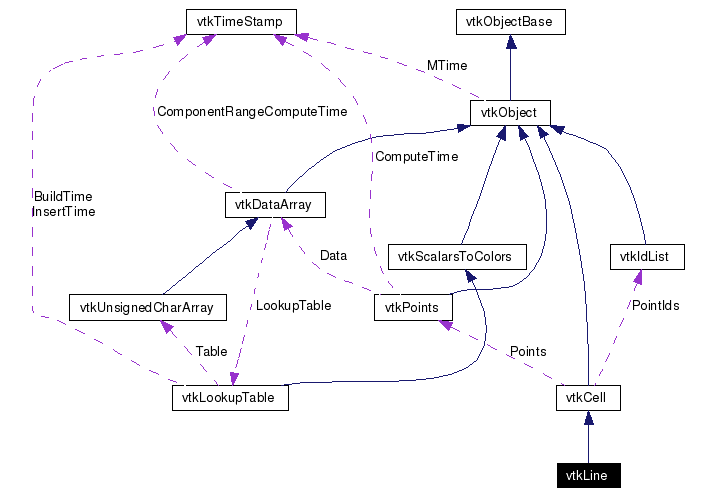
#include <vtkLine.h>
Inheritance diagram for vtkLine:


vtkLine is a concrete implementation of vtkCell to represent a 1D line.
Definition at line 32 of file vtkLine.h.
Public Types | |
| typedef vtkCell | Superclass |
Public Member Functions | |
| virtual const char * | GetClassName () |
| virtual int | IsA (const char *type) |
| void | PrintSelf (ostream &os, vtkIndent indent) |
| int | GetCellType () |
| int | GetCellDimension () |
| int | GetNumberOfEdges () |
| int | GetNumberOfFaces () |
| vtkCell * | GetEdge (int) |
| vtkCell * | GetFace (int) |
| int | CellBoundary (int subId, double pcoords[3], vtkIdList *pts) |
| void | Contour (double value, vtkDataArray *cellScalars, vtkPointLocator *locator, vtkCellArray *verts, vtkCellArray *lines, vtkCellArray *polys, vtkPointData *inPd, vtkPointData *outPd, vtkCellData *inCd, vtkIdType cellId, vtkCellData *outCd) |
| int | EvaluatePosition (double x[3], double *closestPoint, int &subId, double pcoords[3], double &dist2, double *weights) |
| void | EvaluateLocation (int &subId, double pcoords[3], double x[3], double *weights) |
| int | Triangulate (int index, vtkIdList *ptIds, vtkPoints *pts) |
| void | Derivatives (int subId, double pcoords[3], double *values, int dim, double *derivs) |
| virtual double * | GetParametricCoords () |
| void | Clip (double value, vtkDataArray *cellScalars, vtkPointLocator *locator, vtkCellArray *lines, vtkPointData *inPd, vtkPointData *outPd, vtkCellData *inCd, vtkIdType cellId, vtkCellData *outCd, int insideOut) |
| int | GetParametricCenter (double pcoords[3]) |
| int | IntersectWithLine (double p1[3], double p2[3], double tol, double &t, double x[3], double pcoords[3], int &subId) |
Static Public Member Functions | |
| static vtkLine * | New () |
| static int | IsTypeOf (const char *type) |
| static vtkLine * | SafeDownCast (vtkObject *o) |
| static double | DistanceToLine (double x[3], double p1[3], double p2[3]) |
| static void | InterpolationFunctions (double pcoords[3], double weights[2]) |
| static int | Intersection (double p1[3], double p2[3], double x1[3], double x2[3], double &u, double &v) |
| static double | DistanceToLine (double x[3], double p1[3], double p2[3], double &t, double closestPoint[3]) |
Protected Member Functions | |
| vtkLine () | |
| ~vtkLine () | |
|
|
Reimplemented from vtkCell. |
|
|
|
|
|
|
|
|
Create an object with Debug turned off, modified time initialized to zero, and reference counting on. Reimplemented from vtkObject. |
|
|
Reimplemented from vtkCell. |
|
|
Return 1 if this class type is the same type of (or a subclass of) the named class. Returns 0 otherwise. This method works in combination with vtkTypeRevisionMacro found in vtkSetGet.h. Reimplemented from vtkCell. |
|
|
Return 1 if this class is the same type of (or a subclass of) the named class. Returns 0 otherwise. This method works in combination with vtkTypeRevisionMacro found in vtkSetGet.h. Reimplemented from vtkCell. |
|
|
Reimplemented from vtkCell. |
|
||||||||||||
|
Methods invoked by print to print information about the object including superclasses. Typically not called by the user (use Print() instead) but used in the hierarchical print process to combine the output of several classes. Reimplemented from vtkCell. |
|
|
See the vtkCell API for descriptions of these methods. Implements vtkCell. Definition at line 41 of file vtkLine.h. References VTK_LINE. |
|
|
Return the topological dimensional of the cell (0,1,2, or 3). Implements vtkCell. |
|
|
Return the number of edges in the cell. Implements vtkCell. |
|
|
Return the number of faces in the cell. Implements vtkCell. |
|
|
Return the edge cell from the edgeId of the cell. Implements vtkCell. |
|
|
Return the face cell from the faceId of the cell. Implements vtkCell. |
|
||||||||||||||||
|
Given parametric coordinates of a point, return the closest cell boundary, and whether the point is inside or outside of the cell. The cell boundary is defined by a list of points (pts) that specify a face (3D cell), edge (2D cell), or vertex (1D cell). If the return value of the method is != 0, then the point is inside the cell. Implements vtkCell. |
|
||||||||||||||||||||||||||||||||||||||||||||||||
|
Generate contouring primitives. The scalar list cellScalars are scalar values at each cell point. The point locator is essentially a points list that merges points as they are inserted (i.e., prevents duplicates). Contouring primitives can be vertices, lines, or polygons. It is possible to interpolate point data along the edge by providing input and output point data - if outPd is NULL, then no interpolation is performed. Also, if the output cell data is non-NULL, the cell data from the contoured cell is passed to the generated contouring primitives. (Note: the CopyAllocate() method must be invoked on both the output cell and point data. The cellId refers to the cell from which the cell data is copied.) Implements vtkCell. |
|
||||||||||||||||||||||||||||
|
Given a point x[3] return inside(=1) or outside(=0) cell; evaluate parametric coordinates, sub-cell id (!=0 only if cell is composite), distance squared of point x[3] to cell (in particular, the sub-cell indicated), closest point on cell to x[3] (unless closestPoint is null, in which case, the closest point and dist2 are not found), and interpolation weights in cell. (The number of weights is equal to the number of points defining the cell). Note: on rare occasions a -1 is returned from the method. This means that numerical error has occurred and all data returned from this method should be ignored. Also, inside/outside is determine parametrically. That is, a point is inside if it satisfies parametric limits. This can cause problems for cells of topological dimension 2 or less, since a point in 3D can project onto the cell within parametric limits but be "far" from the cell. Thus the value dist2 may be checked to determine true in/out. Implements vtkCell. |
|
||||||||||||||||||||
|
Determine global coordinate (x[3]) from subId and parametric coordinates. Also returns interpolation weights. (The number of weights is equal to the number of points in the cell.) Implements vtkCell. |
|
||||||||||||||||
|
Generate simplices of proper dimension. If cell is 3D, tetrahedron are generated; if 2D triangles; if 1D lines; if 0D points. The form of the output is a sequence of points, each n+1 points (where n is topological cell dimension) defining a simplex. The index is a parameter that controls which triangulation to use (if more than one is possible). If numerical degeneracy encountered, 0 is returned, otherwise 1 is returned. This method does not insert new points: all the points that define the simplices are the points that define the cell. Implements vtkCell. |
|
||||||||||||||||||||||||
|
Compute derivatives given cell subId and parametric coordinates. The values array is a series of data value(s) at the cell points. There is a one-to-one correspondence between cell point and data value(s). Dim is the number of data values per cell point. Derivs are derivatives in the x-y-z coordinate directions for each data value. Thus, if computing derivatives for a scalar function in a hexahedron, dim=1, 8 values are supplied, and 3 deriv values are returned (i.e., derivatives in x-y-z directions). On the other hand, if computing derivatives of velocity (vx,vy,vz) dim=3, 24 values are supplied ((vx,vy,vz)1, (vx,vy,vz)2, ....()8), and 9 deriv values are returned ((d(vx)/dx),(d(vx)/dy),(d(vx)/dz), (d(vy)/dx),(d(vy)/dy), (d(vy)/dz), (d(vz)/dx),(d(vz)/dy),(d(vz)/dz)). Implements vtkCell. |
|
|
Return a contiguous array of parametric coordinates of the points defining this cell. In other words, (px,py,pz, px,py,pz, etc..) The coordinates are ordered consistent with the definition of the point ordering for the cell. This method returns a non-NULL pointer when the cell is a primary type (i.e., IsPrimaryCell() is true). Note that 3D parametric coordinates are returned no matter what the topological dimension of the cell. Reimplemented from vtkCell. |
|
||||||||||||||||||||||||||||||||||||||||||||
|
Clip this line using scalar value provided. Like contouring, except that it cuts the line to produce other lines. Implements vtkCell. |
|
|
Return the center of the triangle in parametric coordinates. Reimplemented from vtkCell. |
|
||||||||||||||||||||||||||||||||
|
Line-line intersection. Intersection has to occur within [0,1] parametric coordinates and with specified tolerance. Implements vtkCell. |
|
||||||||||||||||||||||||||||
|
Performs intersection of two finite 3D lines. An intersection is found if the projection of the two lines onto the plane perpendicular to the cross product of the two lines intersect. The parameters (u,v) are the parametric coordinates of the lines at the position of closest approach. |
|
||||||||||||||||||||||||
|
Compute the distance of a point x to a finite line (p1,p2). The method computes the parametric coordinate t and the point location on the line. Note that t is unconstrained (i.e., it may lie outside the range [0,1]) but the closest point will lie within the finite line [p1,p2]. Also, the method returns the distance squared between x and the line (p1,p2). |
|
||||||||||||||||
|
Determine the distance of the current vertex to the edge defined by the vertices provided. Returns distance squared. Note: line is assumed infinite in extent. |
|
||||||||||||
|
Line specific methods. |
 1.4.3-20050530
1.4.3-20050530